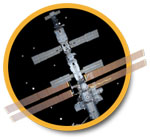
The International Space Station (ISS) is an amazing undertaking comprising technology, engineering, science and math--the perfect context for exciting students for learning. NASA research leads to technological advances on Earth and in human space exploration. As NASA plans for manned missions to Mars, scientists explore our solar system and beyond for determining if and where life could exist. Extremophiles are fascinating for teaching Earth science in a context for astrobiology research. The course explores how space travel impacts the human body; growing food in space; engineering protection from radiation, and searching for habitable environments. With its application of subject matter, it offers excellent resources and interactions with NASA scientists, and data for educators to bring the exciting context of space travel to the classroom.
| Integrate current research from NASA missions with International Space Station in your lessons. Human space travel includes amazing phenomena for STEM teaching! |
Participants attend 5 LIVE, online sessions in a user-friendly format, which include, but are not limited to the following topics:
Session 1: Humans in Space
Session 2: Life aboard ISS: Humans in microgravity
Session 3: Astrobiology
Session 4: Integrating Math, Science and more through Engineering Design Challenges
Session 5: Extreme Environments / Earth Analogues
All NGSS Disciplinary Core Ideas are integrated into this course. The specific focus of assignments and discussions are tailored by the participants needs.
Participants may implement course content and develop a portfolio following the guidelines of the National Board for Professional Teaching Standards, with the goal of submitting work for National Board Certification.
Educators may seek opportunities to present at conferences, or among colleagues and education community stakeholders. Course instructors and mentors will support your individual goals to become leaders in integrated STEM education.
Upon completion of this course, students will be able to: